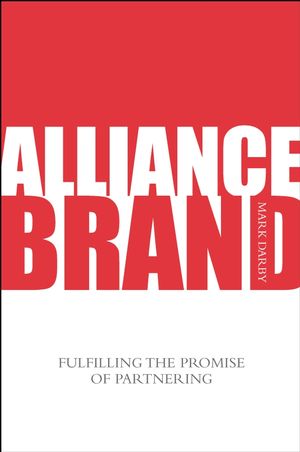Alliance Brand: Fulfilling the Promise of PartneringISBN: 978-0-470-03218-3
Hardcover
408 pages
August 2006
 This is a Print-on-Demand title. It will be printed specifically to fill your order. Please allow an additional 10-15 days delivery time. The book is not returnable.
|
||||||
FOREWORD BY JEFF ALEXANDER, SEEDA xiii
ACKNOWLEDGEMENTS xv
PREFACE xix
PART I USING ALLIANCES TO CREATE VALUE 1
1 HOW VALUE AND ADVANTAGE AFFECT FIRM ACTIVITIES 3
What is value 3
Understanding competitive advantage 6
2 UNDERSTANDING ALLIANCES 13
Alliance ambiguity 13
Defining alliances 14
What alliances are not 16
Assets are what you access 17
Alliances pervade the value chain 18
Alliances have differing values and importance 21
Partners come from various sources 24
Complex relationships 26
3 FORCES DRIVING FOR ALLIANCES 29
Customer demands and industry standards 30
Increasing pace of change with growth and cost pressures 31
Regulation and governance 33
Increasing M&A challenges 35
Capital, size, learning and competitive threat 36
4 WHAT WINNING ALLIANCES LOOK LIKE 39
Alliance spirit 39
Building trust 40
What an organisation that wins with alliances does for success 47
5 FORCES CHALLENGING ALLIANCE SUCCESS 53
Alliance failure rates 53
Other forces challenging success 60
6 ALLIANCE BRAND 67
Reputation in context 67
Brand in context 70
Alliance brand; a timely initiative 72
Examples of alliance brands 76
Getting results, reputation and alliance brand status 80
Does your organisation need an alliance brand? 82
PART I SUMMARY 85
PART II HAVING A CAPABILITY TO PARTNER 87
7 CLARITY ON STRATEGY AND DIRECTION 91
The importance of clarity on strategy and direction 92
Pitfalls to avoid 96
Achieving clarity on strategy and direction 98
How to ensure the strategy and direction create value 100
8 CLARITY ON CORE COMPETENCES 105
The importance of clarity on core competences 106
Defining core competences 107
Effective internal analysis 110
The challenges of internal analysis 121
What happens next 122
9 ABILITY TO MAKE EFFECTIVE STRATEGIC CHOICES 125
Alliances are only one option 125
Strengths and weaknesses of other options 126
Bringing it together in a coherent framework 129
10 ATTRACTIVENESS OF ASSETS 135
Using assets effectively 135
Leveraging assets 140
Identifying assets 140
Assessing values 142
Conducting asset risk assessments 144
Setting the framework for use and monitoring its effectiveness 146
11 ABILITY TO COLLABORATE INTERNALLY AND EXTERNALLY 149
Collaborative cultures 149
Factors affecting collaboration 152
12 ABILITY TO GOVERN EFFECTIVELY AND MANAGE COMPLEX RELATIONSHIPS 177
View increasing legislation as opportunity not threat 178
Dealing effectively with complex relationships 183
Managing reciprocity 191
13 EFFECTIVENESS OF ALLIANCE INFRASTRUCTURE 193
Ability to segment, measure and manage overall portfolio performance 194
Programme fit and importance within the firm 204
Resources focused on alliance activity 208
Ease of doing and not doing business with other parties 223
Proposition attractiveness 227
Ability to select the right partners and relationships 232
Ability to deliver on alliance commitments 234
Ability to develop, protect and share knowledge 239
PART II SUMMARY 243
PART III WINNING WITH ALLIANCES 245
14 PHASE 1: PRE-ALLIANCE 249
Context 249
Phase 1 aims 250
Output A: forces pushing for the alliance 250
Output B: alliance as the right choice 252
Output C: headline benefits 253
Output D: headline risks 253
Output E: sponsor identified and stakeholders on board 254
Output F: support resources and costs 257
Progress to Phase 2 257
Pitfalls to avoid 258
Summary of tools needed for Phase 1 258
15 PHASE 2: PRE-PARTNER 261
Context 261
Phase 2 aims 262
Output A: alliance team alignment 262
Output B: attractive value proposition for the participants 266
Output C: organisation readiness 275
Output D: ideal partner characteristics 278
Output E: engagement plan and partner selection 283
Output F: stakeholder and risk management 288
Progress to Phase 3 288
Pitfalls to avoid 288
Summary of tools needed for Phase 2 290
16 PHASE 3: WITH-PARTNER PLANNING 293
Context 293
Phase 3 aims 294
Output A: compelling value proposition and targets aligned 294
Output B: complete mutual due diligence 299
Output C: effective relationship architecture designed 300
Progress to Phase 4 314
Pitfalls to avoid 314
Summary of tools needed for Phase 3 316
17 PHASE 4: ALLIANCE LAUNCH 317
Context 317
Phase 4 aims 318
Output A: project and change management 319
Output B: announcing the alliance 321
Progress to Phase 5 322
Pitfalls to avoid 322
Summary of tools needed for Phase 4 323
18 PHASE 5: WITH-PARTNER DELIVERY 325
Context 325
Phase 5 aims 326
Outputs A and B: results and relationships 326
Progress to Phase 6 332
Pitfalls to avoid 332
Summary of tools needed for Phase 5 333
19 PHASE 6: ALLIANCE REVIEWS 335
Context 335
Phase 6 aims 336
Output A: objective assessment 336
Output B: actions and next steps 341
Progress 342
Pitfalls to avoid 343
Summary of tools needed for Phase 6 343
20 THE JOURNEY TO ALLIANCE BRAND AND WINNING ALLIANCES 345
Getting started 346
Standing out from the crowd 349
ALLIANTIST services 350
Concluding remarks 351
APPENDIX ALLIANCE BRAND QUICK TEST 353
REFERENCES 357
INDEX 363



